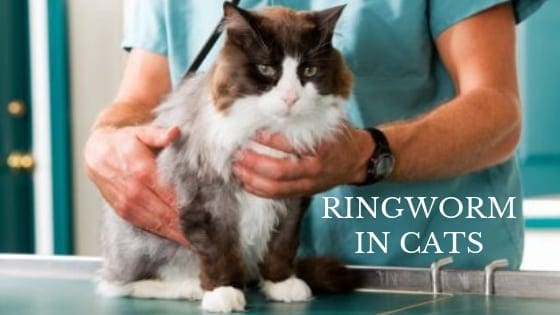What is Ringworm?
Although it’s called ringworm it’s not actually a worm. Ringworm is a fungus. It gets its descriptive name from how it appears on the skin as a raised, round ring, although not all infections look ring-like. The medical name for ringworm is dermatophytosis. This highly contagious fungal infection affects both pets and humans. Ringworm spores can be found on the animal or in the environment such on the bedding — anything that comes in contact with the animal’s hair. The microscopic organisms known as dermatophytes, feed on the keratin in the animal’s nails and hair.
In cats, ringworm is commonly found on the front legs, head, chest area and down the back.
How it’s Transmitted
Transmission occurs by coming in direct contact with the infected animal’s hair or by coming in contact items in an environment that have also been in contact with the animal’s hair. The fungal spores can live on items in the environment in a dormant state for up to 18 months. Young cats, ones living in stressful conditions or cat-dense environments, senior cats, and ones with compromised immune systems are more likely to become infected. Many healthy adults usually have a resistance to the fungal infection.
Symptoms of Ringworm
The typical symptom is a crusty skin patch with missing hair or broken-off, stubble-like hair. You may also notice skin inflammation, dandruff, or nail infections. The cat may groom or scratch excessively. Lesions most commonly appear on the head, ears, tail or nails. Ringworm lesions may or may not cause irritation and itching.
Diagnosis of Ringworm
A fungal culture is the most reliable method. The veterinarian will collect skin scales and hair samples to culture. A less reliable method is through the use of a Wood’s lamp. This is a special black light that causes the fungus to fluoresce. Not all types of ringworm fluoresce though.
Treatment of Ringworm
Topical medication will be prescribed along with oral anti-fungal drugs. A dip performed at the veterinary clinic may also be prescribed. Several fungal cultures are repeated after treatment to ensure the infection has completely cleared. Treatment of ringworm can take up to six weeks, and sometimes longer.
The Environment Must be Treated as Well
The fungal spores can live quite a while in the environment so an important part of treatment involves thorough cleaning. Vacuum and steam-clean carpets. Clean floors with a damp mop to avoid causing the spores to become airborne. Bleach mop heads afterward. Disinfect all pet bedding, grooming tools, litter boxes, and carriers.
Need More Information?
If you notice any reddened, crusty or bald patches on your cat or notice something doesn’t look normal with the skin or hair, have your cat examined by your veterinarian. If you have a question regarding your cat’s health, please contact your veterinarian. This article is not intended as a replacement for your cat’s veterinary care.
For more information on cat behavior and training, refer to the books by Pam Johnson-Bennett. Pam’s books are available at bookstores and online. We’ve included links to Amazon here on our website.




